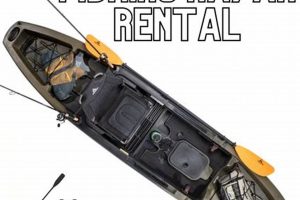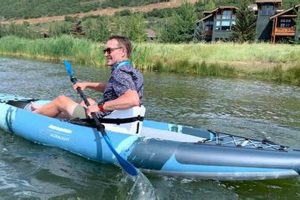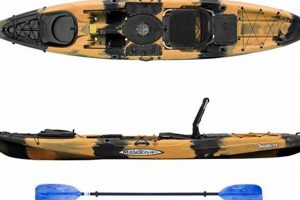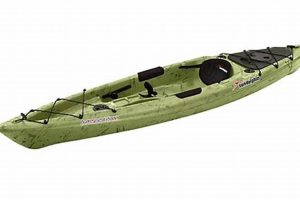Enhanced seating systems for fishing kayaks represent a significant development in angling comfort and functionality. These systems typically involve replacing the factory-installed seat with an aftermarket option designed for improved ergonomics, adjustability, and durability. An example might include exchanging a basic padded seat for one with increased lumbar support, breathable fabric, and multiple adjustable straps.
Improving the kayak seat can dramatically impact the overall fishing experience. A comfortable, supportive seat allows anglers to spend longer hours on the water without experiencing fatigue or discomfort, leading to increased fishing time and potentially greater success. Historically, kayak seats were rudimentary, prioritizing affordability over comfort. However, the growing popularity of kayak fishing has driven innovation in seat design, resulting in a wide range of options to suit individual needs and preferences. This development allows anglers to prioritize both comfort and performance.
The subsequent sections will explore various aspects of choosing and installing improved kayak seating, covering topics such as materials, design features, installation processes, and popular models currently available.
Tips for Selecting Enhanced Kayak Seating
Choosing an appropriate replacement seat requires careful consideration of several factors to ensure optimal comfort and performance on the water.
Tip 1: Evaluate Existing Seating: Objectively assess the current seat’s shortcomings. Consider areas where discomfort arises, such as lack of back support, inadequate cushioning, or limited adjustability. This assessment will guide the selection process.
Tip 2: Prioritize Adjustability: Seats offering multiple adjustment points allow anglers to fine-tune their posture throughout the day, accommodating different fishing techniques and body types. Look for adjustable backrest angles, seat heights, and leg support options.
Tip 3: Consider Materials and Construction: Durable, weather-resistant materials are essential for longevity. High-quality stitching and reinforced stress points contribute to a seat’s overall resilience. Breathable fabrics can enhance comfort in warm weather.
Tip 4: Research Weight Capacity: Ensure the chosen seat supports the angler’s weight and any additional gear. Exceeding the weight limit can compromise stability and safety.
Tip 5: Factor in Kayak Compatibility: Verify the seat’s compatibility with the specific kayak model. Mounting systems and seat dimensions must align with the kayak’s design.
Tip 6: Read Reviews and Seek Recommendations: Consult online reviews and forums for insights from other anglers. Recommendations from experienced kayak anglers can provide valuable real-world perspectives.
Tip 7: Consider Storage Options: Some seats include integrated storage compartments, offering convenient access to essential fishing gear.
By considering these factors, anglers can select seating that enhances comfort, improves fishing performance, and extends time spent on the water. A well-chosen seat promotes a more enjoyable and productive fishing experience.
The following section provides a detailed overview of popular seat models and their respective features, assisting anglers in making an informed purchasing decision.
1. Comfort
Comfort plays a pivotal role in the efficacy of a fishing kayak seat upgrade. Discomfort, often stemming from pressure points, inadequate back support, and limited adjustability, can curtail fishing trips due to fatigue and pain. An upgraded seat alleviates these issues, enabling extended time on the water. The causal link is clear: a comfortable angler can fish longer, increasing the likelihood of success and overall enjoyment. For example, an angler experiencing lower back pain with a standard kayak seat may find relief and extended fishing time with an upgraded seat featuring enhanced lumbar support and adjustable backrests.
Ergonomic design is central to comfort. Features like breathable fabrics, contoured cushioning, and adjustable straps contribute significantly to a positive on-the-water experience. These features address common discomfort issues by promoting proper posture, reducing pressure points, and regulating temperature. The practical significance of this understanding lies in the ability to select a seat upgrade that specifically addresses individual needs and preferences. Anglers who prioritize comfort can target seats with features like adjustable lumbar support and high-density foam padding, leading to greater enjoyment and reduced fatigue during long fishing sessions.
Prioritizing comfort in a fishing kayak seat upgrade directly impacts angling performance and enjoyment. Addressing discomfort through ergonomic design and adjustability enables longer, more productive, and more enjoyable fishing trips. While the initial investment in a comfortable seat may be higher, the long-term benefits outweigh the cost, ultimately contributing to a more fulfilling and successful angling experience.
2. Support
Adequate support is a critical factor in fishing kayak seat upgrades, directly influencing an angler’s comfort, stability, and overall fishing experience. A supportive seat mitigates fatigue and promotes proper posture, allowing for extended periods on the water without physical strain. This discussion will explore key facets of support related to fishing kayak seat upgrades.
- Lumbar Support
Proper lumbar support is crucial for maintaining a healthy posture and preventing lower back pain, a common complaint among anglers. Seats with adjustable lumbar support systems accommodate individual preferences and body types, ensuring optimal spinal alignment. For example, inflatable lumbar supports allow anglers to customize the level of firmness, while molded backrests offer consistent support. Effective lumbar support translates to reduced fatigue and discomfort, allowing for longer, more enjoyable fishing trips.
- Backrest Height and Angle
The backrest’s height and angle significantly impact overall support and comfort. A higher backrest provides greater upper back and shoulder support, while adjustable angles allow anglers to customize their seating position based on their fishing style and the kayak’s design. A kayak designed for stillwater fishing might benefit from a higher backrest angle for relaxed observation, while a kayak used in moving water might require a lower angle for increased paddling efficiency. Choosing the appropriate backrest height and angle contributes to improved posture and reduced strain.
- Seat Pan Design and Padding
The seat pan’s design and padding influence lower body support and pressure distribution. A well-designed seat pan provides even weight distribution, reducing pressure points and promoting circulation. High-density foam padding offers superior comfort and support compared to thinner, less resilient materials. A contoured seat pan can further enhance support by conforming to the body’s shape. Adequate seat pan support contributes to overall comfort and reduces fatigue, especially during long hours on the water.
- Lateral Support
Lateral support, often overlooked, plays a crucial role in maintaining stability, particularly in challenging conditions. Seats with raised side bolsters or adjustable side straps provide additional support, preventing side-to-side movement and enhancing balance. This added stability is particularly beneficial in rough water or when casting and reeling in fish. Improved lateral support contributes to angler safety and confidence, allowing for more focused fishing in various conditions.
These facets of support work in concert to create a comfortable and stable seating experience, contributing significantly to an angler’s overall enjoyment and performance on the water. Selecting a fishing kayak seat upgrade that prioritizes these support features can greatly enhance the angling experience.
3. Durability
Durability is a paramount concern in fishing kayak seat upgrades. Exposure to harsh environmental conditionsincluding UV radiation, saltwater, and fluctuating temperaturesdemands robust materials and construction. A durable seat ensures longevity, minimizing the need for frequent replacements and maximizing return on investment. This discussion will explore key facets of durability related to fishing kayak seat upgrades.
- Material Selection
The choice of materials significantly impacts a seat’s resistance to wear and tear. Marine-grade fabrics, such as UV-resistant polyester and solution-dyed acrylic, offer superior protection against fading, mildew, and abrasion. High-density, closed-cell foam padding resists water absorption and maintains its supportive properties over time. For example, solution-dyed acrylic fibers are colorfast, preventing fading even with prolonged sun exposure, while closed-cell foam padding prevents waterlogging and mildew growth, preserving the seat’s integrity and comfort. Selecting appropriate materials is crucial for ensuring long-term durability.
- Construction Quality
Construction quality directly influences a seat’s ability to withstand stress and resist damage. Reinforced stitching, double-stitched seams, and robust hardware contribute to a seat’s structural integrity. High-quality stitching prevents unraveling and tearing, particularly in high-stress areas like attachment points and seams. Rust-resistant hardware, such as stainless steel or anodized aluminum, ensures long-lasting functionality and prevents corrosion in saltwater environments. For example, double-stitched seams in high-stress areas provide additional reinforcement, enhancing the seat’s resistance to tearing under pressure.
- Frame Construction
The frame provides structural support and contributes significantly to the seat’s overall durability. Aluminum frames offer a balance of strength and lightweight properties, while corrosion-resistant coatings further enhance their longevity. High-impact plastics, such as reinforced nylon, provide an alternative to metal frames, offering excellent durability and resistance to cracking or breaking. Choosing a robust frame ensures the seat maintains its shape and supportive properties over time, even under heavy use. A well-constructed frame provides a stable platform for the seat cushion and backrest, preventing sagging and ensuring long-term comfort.
- UV Resistance
Prolonged exposure to ultraviolet radiation can degrade materials, causing fading, cracking, and weakening. UV-resistant coatings and materials protect the seat from sun damage, extending its lifespan. Solution-dyed fabrics offer inherent UV resistance, as the color is integrated into the fibers during manufacturing, unlike traditional dyeing methods where color is applied to the surface. A UV-resistant seat maintains its appearance and structural integrity despite prolonged sun exposure, ensuring long-term performance and aesthetic appeal.
Investing in a durable fishing kayak seat ensures long-term comfort and performance. Prioritizing materials, construction quality, frame robustness, and UV resistance contributes to a seat’s ability to withstand the rigors of the marine environment. The long-term benefits of durability outweigh the initial cost, as a durable seat minimizes the need for replacements and ensures lasting comfort and support on the water, ultimately enhancing the overall fishing experience.
4. Adjustability
Adjustability represents a crucial element in fishing kayak seat upgrades, directly impacting angler comfort, performance, and overall fishing experience. A highly adjustable seat accommodates diverse body types, fishing styles, and on-the-water conditions, maximizing comfort and minimizing fatigue. The relationship between adjustability and seat upgrades hinges on the ability to customize the seat’s configuration to meet individual needs.
Several adjustable features contribute significantly to a customized and comfortable experience. Adjustable backrests allow anglers to fine-tune the angle of recline, promoting proper posture and reducing strain on the back and shoulders. This customization becomes particularly relevant during long fishing trips, where maintaining a comfortable posture is essential for preventing fatigue. An angler targeting different species might adjust the backrest angle for optimal sightlines and casting positions. For example, a higher backrest angle may be preferable for sight fishing, while a lower angle might be more suitable for casting in windy conditions. Similarly, adjustable seat heights cater to varying leg lengths and kayak designs, ensuring proper legroom and paddling ergonomics. Furthermore, adjustable lumbar support systems accommodate individual preferences and body types, providing customized lower back support and mitigating potential discomfort. An angler with a history of lower back pain might require more pronounced lumbar support than an angler without such issues. The ability to fine-tune these features contributes directly to comfort and reduces the likelihood of pain or fatigue, ultimately extending time on the water.
The practical implications of seat adjustability extend beyond mere comfort. A well-adjusted seat enhances stability and balance, crucial factors for safe and effective kayak fishing. By providing proper support and alignment, an adjustable seat allows anglers to maintain a secure and balanced position, especially in challenging conditions such as rough water or when landing a fish. This enhanced stability translates to increased confidence and improved fishing performance. Moreover, adjustable features cater to diverse fishing styles. An angler frequently switching between paddling and casting can easily adjust the seat position to optimize for each activity. A higher seat position might be preferable for paddling, offering better leverage and visibility, while a lower position might enhance stability and casting accuracy. In conclusion, prioritizing adjustability in fishing kayak seat upgrades is essential for maximizing comfort, performance, and overall fishing experience. The ability to customize seat settings to individual needs and preferences significantly impacts on-the-water comfort and effectiveness, ultimately contributing to a more enjoyable and successful angling experience.
5. Breathability
Breathability is a critical factor in fishing kayak seat upgrades, significantly impacting angler comfort, particularly during warm weather or strenuous paddling. A breathable seat promotes airflow, reducing heat buildup and perspiration, thus enhancing comfort and preventing skin irritation. This discussion will explore the multifaceted relationship between breathability and fishing kayak seat upgrades.
- Material Composition
The materials used in the seat’s construction directly influence its breathability. Open-weave fabrics, such as mesh or breathable polyester, allow for greater airflow compared to dense, non-porous materials. Mesh panels strategically placed in high-perspiration areas, like the back and seat bottom, facilitate ventilation and enhance comfort. For example, a seat constructed with a closed-cell foam base and a breathable mesh backrest offers both cushioning and ventilation. Choosing breathable materials is paramount for staying cool and dry, especially during extended periods on the water in warm climates.
- Ventilation Design
The seat’s design contributes significantly to its ventilation capabilities. Channels or grooves within the seat’s padding promote airflow, while elevated mesh panels create space between the angler and the seat, further enhancing breathability. Seats designed with strategically placed ventilation cutouts maximize airflow while maintaining structural integrity. A kayak seat with a ventilated backrest and seat pan allows for continuous airflow, preventing heat and moisture buildup. Proper ventilation design is crucial for maintaining comfort and preventing discomfort caused by excessive sweating.
- Moisture Wicking Properties
Moisture-wicking fabrics actively draw perspiration away from the skin, aiding in evaporation and keeping the angler cool and dry. These fabrics often utilize synthetic materials designed to transport moisture away from the body. A seat cover made from a moisture-wicking material helps regulate body temperature and prevents the discomfort associated with sitting in damp clothing. This feature becomes particularly important in humid environments where evaporation rates are slower. Incorporating moisture-wicking properties into the seat design enhances comfort and reduces the risk of skin irritation caused by prolonged moisture exposure.
- Impact on Long-Term Comfort
The breathability of a fishing kayak seat directly impacts long-term comfort and overall fishing enjoyment. A breathable seat minimizes discomfort caused by heat buildup, perspiration, and skin irritation, allowing anglers to focus on fishing rather than physical discomfort. This enhanced comfort translates to longer fishing trips and improved overall satisfaction. By prioritizing breathability, anglers can maximize their time on the water and fully enjoy their fishing experience, unhindered by discomfort related to heat and moisture.
By considering these facets of breathability, anglers can select a fishing kayak seat upgrade that optimizes comfort and performance. A breathable seat significantly enhances the overall fishing experience, particularly in warm or humid conditions, by promoting airflow, reducing perspiration, and preventing skin irritation. The long-term benefits of a breathable seat outweigh any potential cost considerations, as it directly contributes to angler comfort and enjoyment on the water.
6. Installation
Proper installation is crucial for realizing the full benefits of a fishing kayak seat upgrade. A correctly installed seat ensures stability, safety, and optimal comfort, while improper installation can negate the advantages of the upgrade and even create safety hazards. The connection between installation and seat upgrades hinges on the understanding that even the highest-quality seat will underperform if not securely and correctly mounted.
Several factors influence the installation process. Compatibility between the seat and the kayak is paramount. Seats designed for specific kayak models ensure proper fit and secure attachment points. Utilizing appropriate mounting hardware, including corrosion-resistant screws and bolts, is essential for long-term stability and safety. Following manufacturer instructions precisely ensures correct installation and minimizes the risk of damage to the kayak or the seat. For example, using incorrect screw lengths can damage the kayak’s hull or prevent the seat from being securely fastened. Furthermore, adjusting the seat’s position after installation allows for customization based on individual preferences and fishing styles. An angler might adjust the seat’s fore-and-aft position to optimize balance and paddling efficiency or adjust the backrest angle for optimal casting and reeling positions. Properly adjusting the seat after installation maximizes comfort and performance.
Practical implications of correct installation are significant. A securely mounted seat enhances stability, reducing the risk of tipping or capsizing, particularly in challenging conditions. Correct installation also maximizes the seat’s comfort and support features, contributing to reduced fatigue and increased fishing time. Conversely, improper installation can lead to discomfort, instability, and potential safety hazards. A loose seat can shift unexpectedly, compromising balance and potentially leading to a fall. Furthermore, a poorly installed seat can damage the kayak, requiring costly repairs. Therefore, careful attention to installation details is essential for maximizing the benefits of a fishing kayak seat upgrade. Understanding the importance of proper installation and following manufacturer guidelines ensures a safe, comfortable, and enjoyable fishing experience.
7. Cost
Cost represents a significant factor in fishing kayak seat upgrades, influencing material selection, features, and overall quality. A wide price range exists, reflecting varying levels of comfort, durability, and adjustability. Budget-conscious anglers might prioritize basic functionality and durability, opting for simpler designs with fewer adjustable features. Conversely, anglers prioritizing premium comfort and performance might invest in high-end models incorporating advanced materials and ergonomic designs. For example, a basic padded seat with limited adjustability might cost significantly less than a seat featuring breathable mesh, adjustable lumbar support, and multiple reclining positions. Understanding this relationship allows anglers to balance budget considerations with desired features and performance expectations.
Several factors contribute to the overall cost of a fishing kayak seat upgrade. Material selection plays a crucial role, with premium materials like marine-grade fabrics and high-density foam padding typically commanding higher prices. Construction quality, including stitching, hardware, and frame materials, also influences cost. Seats with robust construction and durable components often come at a premium. Furthermore, features such as adjustable backrests, lumbar support systems, and integrated storage compartments contribute to overall cost. For example, a seat with multiple adjustment points and integrated storage might cost more than a seat with basic adjustability and no storage. Analyzing these cost components enables informed purchasing decisions aligned with individual needs and budgetary constraints. Recognizing the interplay between cost, materials, construction, and features allows anglers to select the best seat upgrade within their budget.
The practical implications of cost considerations are substantial. Investing in a higher-quality, albeit more expensive, seat often translates to enhanced comfort, durability, and performance, potentially justifying the higher initial cost through extended lifespan and improved fishing experiences. Conversely, opting for a less expensive seat might compromise comfort or durability, potentially requiring more frequent replacements in the long run. Therefore, careful evaluation of cost versus features is crucial for maximizing value and ensuring a worthwhile investment. Balancing budget constraints with desired features ensures anglers select a seat upgrade that meets both their financial and performance requirements, ultimately enhancing their fishing experience without undue financial strain.
Frequently Asked Questions
This section addresses common inquiries regarding fishing kayak seat upgrades, providing concise and informative responses to assist in decision-making.
Question 1: What are the primary benefits of upgrading a fishing kayak seat?
Upgrading provides enhanced comfort, improved support, increased adjustability, and greater durability, contributing to longer, more enjoyable fishing trips.
Question 2: How does seat compatibility factor into the upgrade process?
Kayak seat compatibility is crucial. One must ensure the chosen seat aligns with the kayak’s mounting system and dimensions for secure and proper installation. Consulting manufacturer specifications is recommended.
Question 3: What materials offer the best durability and weather resistance?
Marine-grade fabrics, such as UV-resistant polyester and solution-dyed acrylic, combined with closed-cell foam padding, offer superior resistance to fading, mildew, and water absorption.
Question 4: How does lumbar support contribute to overall comfort?
Proper lumbar support maintains spinal alignment, reducing lower back strain and fatigue, which is especially important during prolonged fishing trips.
Question 5: What role does adjustability play in seat selection?
Adjustability allows customization of backrest angle, seat height, and lumbar support to accommodate individual body types and fishing styles, optimizing comfort and performance.
Question 6: What are the key cost considerations associated with seat upgrades?
Cost varies based on materials, construction quality, features, and brand reputation. Balancing budget with desired features and durability requirements informs purchasing decisions.
Careful consideration of these frequently asked questions empowers informed decision-making regarding fishing kayak seat upgrades. Selecting an appropriate upgrade significantly enhances on-the-water comfort, performance, and overall fishing experience.
The next section will delve into specific product recommendations and reviews, offering further guidance in selecting the ideal fishing kayak seat upgrade.
Fishing Kayak Seat Upgrades
Upgrading a fishing kayak seat represents a significant investment in on-the-water comfort and performance. This exploration has highlighted the critical aspects of such upgrades, emphasizing the interplay of comfort, support, durability, adjustability, breathability, installation, and cost. Material selection, construction quality, and design features contribute significantly to a seat’s overall performance and longevity. Prioritizing these factors ensures a worthwhile investment that enhances the angling experience.
Ultimately, selecting an appropriate fishing kayak seat upgrade empowers anglers to spend more time on the water, focusing on the pursuit of fish rather than battling discomfort. Careful consideration of individual needs, kayak compatibility, and budgetary constraints leads to informed decisions and contributes to a more rewarding and productive fishing experience. The evolution of kayak seat technology continues to improve comfort and performance, promising further advancements in angling ergonomics and on-the-water enjoyment.






